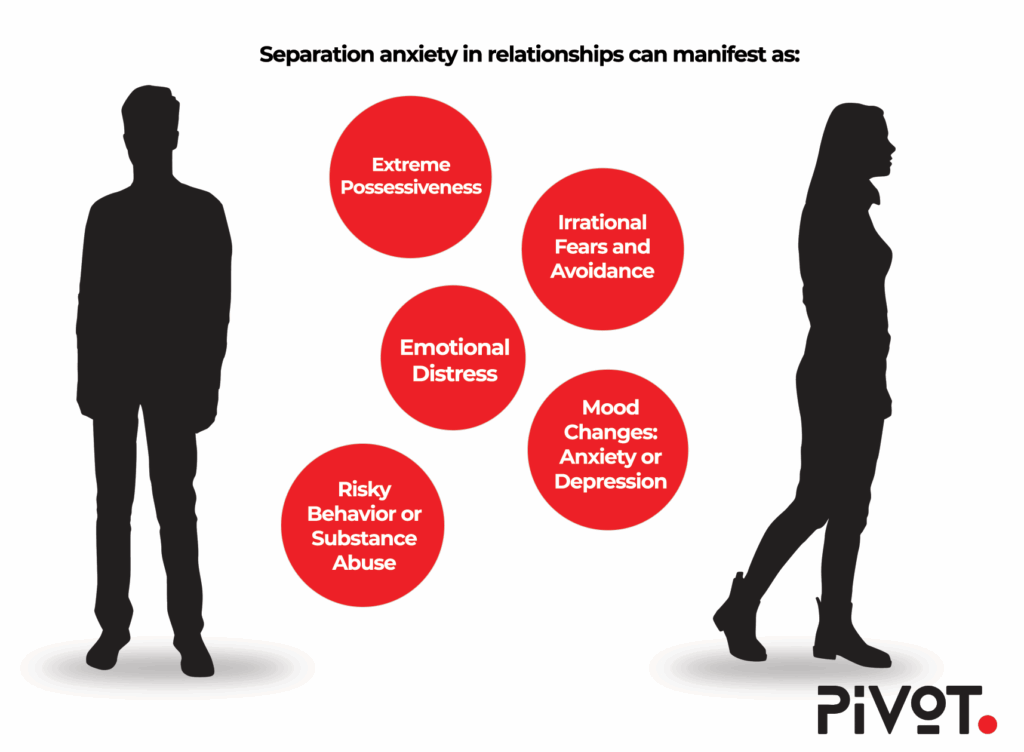Even if a picture of a crying child as parents leave for work is the first thing that pops into your mind when you hear the words separation anxiety, the feeling behind it might not seem so distant or childish to many people. People suffering from adult separation anxiety in relationships usually feel a strong and irrational fear they might lose a loved one, most frequently a romantic partner, in various ways. Those can include injury, accidents, illness, and death, or they may fear being broken up with or abandoned by the person they love.
The overwhelming fear of being away from people you love, particularly your partner, can be quite familiar to many adults in their closest relationships; most of us can think of at least a few examples of having felt this way. While it’s perfectly normal to occasionally feel lonely when you’re away from your partner, in some cases, these feelings get out of control and can cause severe distress and pain. This is a clear sign you may be suffering from separation anxiety in relationships.
How Do I Know If I Have Separation Anxiety in Relationships?

While nobody likes to be away from the people they love, there are cases when people feel irrational fear, panic, anxiety, and overall distress at the very thought of not being around their loved ones. Adults who suffer from separation anxiety disorder experience both emotional and physical symptoms that include negative thoughts and obsessive worrying.
Separation anxiety is not equally serious in all cases. It can be mild for some, while others may experience overwhelming levels of stress and anxiety, preventing them from the most basic functioning in their everyday lives. If you’ve been living with these feelings, you might not even realize something is wrong.
You may be suffering from separation anxiety in relationships if:
- You feel unfounded and excessive worry and fear that people you love might disappear from your life, leave you, or pass away.
- You refuse to be away from your loved ones and experience severe distress if you do.
- You have difficulty sleeping when you’re away from your partner and feel extreme fear that something bad might happen to them.
- You experience frequent depression or anxiety episodes or have panic attacks if separated from your loved one for a period of time. Just thinking about being away from them can trigger strong negative emotions.
- Your daily commitments, work, parenting, self-care, etc., are compromised due to your fear of being away from loved ones, crippling your productivity and decision-making skills.
If this sounds like you, you aren’t alone, and you aren’t stuck. The first step in healing separation anxiety in relationships is understanding where it comes from. Relationship coaching can help you explore how your past relationships and environment made you feel unstable and fearful in your connections. This soul-searching work must be done in order to build healthier coping skills and heal your relationships.
What Can Cause Separation Anxiety in Relationships?
The causes of separation anxiety can be divided into several categories. Children of parents suffering from anxiety are more likely to experience it both as children and as grownups. Adults who are already diagnosed with generalized anxiety disorder can often experience separation anxiety as one of the many manifestations of this type of disorder. Environmental factors and various stressors experienced later in life can also play a role in developing separation anxiety.
| Common Causes of Separation Anxiety in Adults | |
| Codependency | Codependency in a romantic relationship and putting your partner’s needs above your own can create anxiety for both you and your partner. |
| History of rejection | A history of rejection or abandonment in previous relationships can cause you to constantly worry it will happen again. |
| Childhood attachment issues | Childhood neglect, abandonment, or other attachment issues can create deep-seated anxieties later in life. |
| Stressful environments | Adverse environmental conditions or stressful changes are destabilizing and can create an atmosphere for anxiety to grow. |

What Are the Negative Effects of Separation Anxiety on Your Relationship?
Separation anxiety is most obvious in romantic relationships, which inherently makes people feel vulnerable and exposed. An anxious attachment style, which can develop during early childhood, can also amplify feelings of separation anxiety in romantic relationships. Being intimate with someone and opening up to them may also mean revisiting a lot of suppressed emotions, including those from early childhood. When people are unaware of the underlying causes of their separation anxiety issues, it can cause a wide range of problems in romantic relationships.

There are, of course, cases when separation anxiety isn’t completely unfounded. People who enter romantic relationships with partners with avoidant attachment styles may be particularly susceptible to these issues.
Behaviors by love-avoidant people can make the situation worse, as those individuals crave independence and self-reliance. Love-avoidant individuals don’t feel comfortable relying on others or having others depend on them, so they tend to push their romantic partners away, easily triggering separation anxiety in the other partner.
Learn Coping Strategies for Relationship Separation Anxiety
If you recognize some of the behaviors and feelings in yourself or a partner, you might benefit from learning coping strategies to manage separation anxiety in relationships. While learning how to deal with such feelings requires some effort, professional guidance is available to help you make healthy attachments.
Managing separation anxiety involves developing healthy habits and activities that can alleviate feelings of anxiety when apart from your partner.
You can make the first step through PIVOT coaching sessions or retreats at the Glass House. Our experienced and caring relationship coaches can help you recognize and change unhealthy thoughts and behavior patterns, which can, in turn, make you better equipped to deal with your romantic relationship issues.
When you work with us, we can help you explore your and your partner’s attachment styles, communication patterns, and past traumas that are influencing your current relationship. We work with individuals and couples, both separately and together, to heal their connections and move forward in a healthier way.
Transform Your Relationships With PIVOT
PIVOT offers relationship coaching for individuals, duos, couples, and families, as well as business coaching and retreats. Reach out online or call us to begin the journey to a healthier, happier life where you no longer have separation anxiety in relationships.



















